
North America: Baja Cruise
Carnival Cruise Line
In spring 2024, Carnival Firenze will debut, setting sail from this homeport towards south-of-the-border fun along Mexico's Pacific coast! Experience a whole enchilada's worth of rich culture and fun on a cruise to Mexico. Each port — including favorites Cozumel, Cabo San Lucas and Puerto Vallarta — contributes its own distinct local flavor to the mix. Whether your Mexico cruise style is west-coast Riviera with its Pacific charm, east-coast Caribbean and its island mojo… or perhaps Baja and its out-of-this-world coastal scenery, you'll find Mexico central to a great vacation.

Executive Member Benefit
Executive Members receive an annual 2% Reward, up to $1,000, on qualified Costco Travel purchases
Digital Costco Shop Card
Member Exclusive: Digital Costco Shop Card with every Carnival Cruise Line sailing†
Sailing Itinerary

Note: Cruise itineraries are subject to change. Please verify ports and times directly with the cruise line.
Overview
Located about 80 kilometers northwest of Rome, the Port of Civitavecchia is the port of Rome and a busy ferry and cargo port serving Italy and southern Europe. Lying on Italy’s eastern shores on the Tyrrhenian Sea, the Port of Civitavecchia has excellent direct connections to Rome. It is an important cruise and ferry port with regular passage to Sardinia, Malta, Sicily, Tunis, and Barcelona. Fishing is of secondary importance to the Port of Civitavecchia. In addition to ocean-going traffic, the Port of Civitavecchia also contains a thermoelectric center and metallurgical works. In 2006, over 51 thousand people called the Port of Civitavecchia home. The Port of Civitavecchia was built on an earlier Etruscan settlement. Emperor Trajan founded the Port of Civitavecchia in the early 2nd Century, calling it Centumcellae. Today, Trajan’s Port is preserved within today’s Port of Civitavecchia. A busy growing town during the late Roman era, the Port of Civitavecchia was attacked by Vandals and then destroyed by the Saracens in 828 AD. Residents escaped to the nearby Allumiere Mountains where Pope Leo IV built a walled town in 854. Eventually, the people returned to Civitavecchia (the name means “old city”). At the end of the 15th Century, the Port of Civitavecchia was under frequent attack by pirates. The naval arsenal was constructed in 1508. Pope Paul III commissioned the building of the keep, which was designed by Donato Bramante and then finished by Michelangelo in 1537, to protect the Port of Civitavecchia from the pirate attacks. In 1696, Civitavecchia became a free port under Pope Innocent XII. Because it was Rome’s main port, the French occupied the Port of Civitavecchia in 1849. The Port of Civitavecchia was linked to Rome by the Rome and Civitavecchia Rail Road in 1859. When the Port of Civitavecchia became part of the Kingdom of Italy in 1870, it was one of the Papal State’s most strongly-fortified towns when Papal troops welcomed General Nino Bixio on behalf of the Italian unification forces into the Port of Civitavecchia fortress. World War II brought destruction to as much as three-quarters of the Port of Civitavecchia. Reconstruction enlarged the Port of Civitavecchia beyond its pre-war area. The Autorita Portuale Civitavecchia (Port of Rome) is responsible for managing and operating the Port of Civitavecchia as well as the ports of Fiumicino and Gaeta. The modern Port of Civitavecchia is at the center of rail, road, and air networks that link it with central Italy and the world. The Port of Civitavecchia has capacity to handle about 11 million tons of cargo per year and over 1.5 million passengers. Cargoes include forest products, cereals, iron and steel, chemicals, automobiles, containers, and liquid bulk. In 2007, the Port of Civitavecchia welcomed 856 cruise vessels carrying 1.6 million passengers, and the total number of passengers using ferries and cruise vessels was 3.8 million. In 2007, the Port of Civitavecchia handled a total of 7.7 million tons of cargo. This total included 1.5 million tons of liquid bulk, 1.7 million tons of solid bulk, 4.6 million tons of packages, and 31.1 thousand TEUs of containerized cargo. The Port of Civitavecchia contains 28 berths of a total 5.6 thousand meters in length with alongside depths from 6 to 18 meters. Port properties include five warehouses containing 36 thousand square meters for handling and storing cargoes. The intermodal terminal includes seven thousand square meters of storage space and 12.5 thousand square meters for loading/unloading rail cars and parking. The Port of Civitavecchia is one of the busiest ferry ports in the world. Just 80 kilometers northwest of Rome, it is the main tourist destination for people traveling to the Eternal City. It is also a central port for ferries carrying passengers to more local destinations. The ferry terminal offers a complete line of amenities. Different ferry companies offer services to the various destinations. Moby Lines handles crossings to Olbia, Sardinia. Corsica Sardinia Ferries runs services to Golfo Aranci. Grimaldi Ferries carries passengers to Barcelona and Tunis, and Grand Navi Veloci operates a route to Tunis. Ferrovie dello Stato operates a combined rail-ferry service to Golfo Aranci.
Overview
Livorno is situated along the coast of the Ligurian Sea, is one of Italy’s most important ports, both as a commercial and touristic port of call, an industrial centre of national importance and, among all of the Tuscan cities, it is generally considered the youngest, even though its territory holds historical testimonies of remote times that have survived the mass bombings of the Second War World. The city, developed from the end of the XVI century upon request of the Medici family, is famous for being the birthplace of prestigious personalities such as Amedeo Modigliani, Pietro Mascagni and Carlo Azeglio Ciampi. In the past, until the first years of the 20th century it was also a tourist destination of international importance for the presence of important seaside and thermal establishments, that give the city its the name of Montecatini-on-the-sea. Livorno, which at the end of the XIX century counted around 100,000 inhabitants and was the 11th most populated city in Italy and the 2nd in Tuscany, in the last decades has had a notable decline in the number of inhabitants and now is the 3rd most populated city in Tuscany after Florence and Prato.
Overview
Naples, a city in southern Italy, sits on the Bay of Naples. Nearby is Mount Vesuvius, the still-active volcano that destroyed nearby Roman town Pompeii. Dating to the 2nd millennium B.C., Naples has centuries of important art and architecture. The city's cathedral, the Duomo di San Gennaro, is filled with frescoes. Other major landmarks include the lavish Royal Palace and Castel Nuovo, a 13th-century castle.
Overview
Messina is a harbor city in northeast Sicily, separated from mainland Italy by the Strait of Messina. It’s known for the Norman Messina Cathedral, with its Gothic portal, 15th-century windows and an astronomical clock on the bell tower. Nearby are marble fountains decorated with mythological figures, like the Fontana di Orione, with its carved inscriptions, and the Neptune Fountain, topped by a statue of the sea god.
Overview
If you've ever wondered what sort of prize you'd get for saving Europe, look no further than Valletta. Named after La Valette, the Grandmaster who masterminded Malta's successful stand against the Turkish siege of 1565, Valletta became the city of the Knights of the Order of St John and the seat of Malta's government. While travelling through the Mediterranean, Sir Walter Scott described Valletta as 'the city built by gentlemen for gentlemen'. Today it's a beautifully preserved 16th-century walled city, small enough to cover in a few hours without sweating too much in the Mediterranean sun. In fact, the streets were carefully laid out to channel cool breezes in from the harbour. Situated on the northeast coast of Malta, Valletta is the capital, and is built on the promontory of Mount Sciberras which juts out into the middle of a bay. This dissects the bay into two deep harbours: the Grand Harbour to the east and the Marsamxett to the west. Valletta is a rough rectangle at the tip of a peninsula on the coast, just a few hundred metres across in either direction and thus surrounded by water on its northern, eastern and southern sides. The city was named after Jean Parisot de la Valette who was the Grand Master of the Order of the Knight Hospitallers (Knights of Saint John of Jerusalem). This famed religious order of hospitallers was founded in Jerusalem in the 11th century and made their base in Malta after they were expelled from Rhodes by the Ottoman Turks. During the time of Grand Master La Valette, in 1565, the Knights and the Maltese managed to suppress a siege on the island by the forces of Süleyman the Magnificent, Sultan of the Ottoman Empire in what was to become known as one of history's greatest sieges. Following the siege, the building of the city began in the same year 1565 in order to create a base for the defence of the island. Although Grand Master La Valette managed to lay the first stone, he died before its completion. Most of the embellishments of Valletta were done during the time of Grand Master La Cassiere, especially the magnificent St John's Co-Cathedral. The reign of the Knights of St John eventually came to an end with the successful invasion by Napoleon who occupied Malta on his way to Egypt. A Maltese revolt against the French garrison was the catalyst for the occupation of Valletta by the British in 1800. Valetta is also the spot where the Italian fleet surrendered to the Allies in 1943. Valletta's network of streets is laid out in an orthogonal grid dominated by a main artery which crosses the length of the entire city and opens up into a series of squares at its geometric centre, around the Palace of the Grand Masters. The city architecture is inspired by Italian Renaissance planning principles, and served as an early model of urban design. Valletta is one of the most important planned towns of the Renaissance. It equals in its noble architecture, any capital in Europe, while its timeless beauty and artistic treasures make it a well-deserved World Heritage site. There are a number of superb museums here as well as historical sites that are worth visiting. The main thoroughfare in the city is Republic Street. You'll find all the main shops and character-filled side streets leading off from here. For those interested in shopping, Merchant's Street and Lucia Street are the places to go for the most interesting merchandise. Lucia Street is famous for the exquisite silver and gold filigree jewellery sold there. Merchant Street specializes in souvenirs and is also home to a large open market.
Overview
Catania is an ancient port city on Sicily's east coast. It sits at the foot of Mt. Etna, an active volcano with trails leading up to the summit. The city's wide central square, Piazza del Duomo, features the whimsical Fontana dell'Elefante statue and richly decorated Catania Cathedral. In the southwest corner of the square, La Pescheria weekday fish market is a rowdy spectacle surrounded by seafood restaurants.
Overview
Corfu Town (Kerkyra) is a principal port and the largest town in the Ionian islands. It is built between two Venetian castles, having its own unique atmosphere. It is a thriving mass of shops and businesses, set amongst a captivating and charming assortment of elegant buildings, churches, imposing fortresses and narrow alleyways leading to hidden squares. The tall buildings with the 'volta' (arches), the 'cantounia' (narrow flagstoned streets), the 'mouragia' (sea-walls) are showing all a clear Italian influence. One of the most beautiful walks in the town is around the Esplanade (Spianada square), one of the biggest squares in Europe which is the hub of the Corfiot's life. Here you can walk around or sit in one of the many cafe bars underneath the arches of the 'Liston', a name probably derived from a similar promenade in Venice. Liston was built during the imperial French occupation and is reminiscent of the larger 'Arcades' of the Rue de Rivoli in Paris. On the upper side of Esplanade stands a memorial to the British Lord High Commissioner Sir Thomas Maitland, built in 1816 in the shape of a circular building with Ionian columns. The Corfiots call this building 'sterna' (cistern) because this was where the entrance to the largest underground cistern of the town was to be found. Near the Maitland's monument, in front of the building where the Ionian Academy was housed, stands the statue of John Capodistrias, the first President of Greece. It is a work from the end of the 19th century showing the Governor standing deep in thought. Opposite the Liston is the the Old Fortress and 'Anthonas', the Municipal Gardens. In the gardens is the statue of Lord Guilford, showing the founder of the Ionian Academy in his academic robes holding an open book. Nearby are the busts of two famous Corfiots, the poet Lorenzo Mavilis and the writer Dinos Theotokis. At the northern end of Esplanade stands the Palace of St. Michael and St. George, one of the most elegant buildings in Corfu. Opposite the west front of the palace is a beautiful building which now houses the Reading Society of Corfu, the oldest cultural institute in modern Greece, founded in 1836. The Reading Society contains a unique library of Greek and foreign books as well as a large collection of manuscripts, newspapers, periodicals, paintings, maps and engravings mostly related to the Ionian islands. As one's gaze leaves the Esplanade, after lingering on the palace, it embraces a magnificent view towards the coastal road (Arseniou Street) with its sea-walls. Following along this road will take you to the Old Harbour of Corfu and the other Venetian castle, the one called the New Fortress. Along this road the narrow lanes ('cantounia') lead to the Campielo, the oldest quarter of the town. Here the visitor can find the oldest houses and many of the historic churches in Corfu. At the northern end of Capodistria Street stands the Capodistria Mansion, an excellent example of neo-classical architecture. It was built in 1835 by the Corfiot architect John Chronis and is considered one of the most beautiful buildings in Greece. Here John Capodistrias, the first President of Greece, was born. Another notable landmark in the old town is the central market. The most interesting street here is Nickiforou Theotoki as the rows upon rows of 'volta' standing on their stone columns and the tall buildings form one of the most characteristic aspects of Corfu Town. In a little square on Nickiforou Theotoki Street stands the building of the Ionian Bank, which was built in 1846 displaying a well-proportioned facade with finely detailed Ionian pilasters and pediment. On the first floor of the building the Paper Money Museum is housed. At the far end of the square is the Church of St. Spyridon. It shelters the body of St. Spyridon, the patron saint of Corfu and one of the great Saints of Greek Orthodoxy and draws a constant stream of pilgrims from all over Greece every year. On the Evgeniou Voulgareos Street stands the crenellated belfry of the Roman Catholic Church of the Annunciation a venerable building from the end of the 14th century. The whole building was destroyed in the World War II bombing, and the only remains are the belfry, two inscriptions and a bas-relief representing war trophies. Between Evgeniou Voulgareos Street and a modern square stands the most elegant of the Venetian buildings in Corfu, the Town Hall in baroque style. At the end of Moustoxydi Street stands another building of the period of British rule, the historic the Ionian Parliament. At the junction of the Garitsa coastal road and Alexandras Avenue stands the Douglas Obelisk, which also belongs to the same period, erected in honour of the Lord High Commissioner Sir Howard Douglas, to whom Corfu owes a lot of public works and philanthropic institutions.
Overview
Dubrovnik - the city of a unique political and cultural history (the Dubrovnik Republic, the Statute from 1272), of world-famous cultural heritage and beauty (inscribed on the List of World Heritage Sites by Unesco) - is one of the most attractive and famous cities of the Mediterranean. Apart from its outstanding natural beauties and well-preserved cul-tural and historical heritage, Dubrovnik also offers high-quality visitor opportunities. It is also the city of hotels, of high ecological standards and tourist programs, and is equally attractive in all seasons. Its geographical isolation is compensated by high traffic and communication standards - especially through air traffic and fast hydrofoil boats. The tourist development of Dubrovnik started before the First World War; quite soon, the exclusiveness of its attractions made Dubrovnik a powerful international tourist centre. The sightseeing of Dubrovnik and its monuments requires several days. However, already a walk through Stradun, through narrow streets and small squares, monumental ramparts and fortreses, provides enough opportunities to experience the millennial beauty of its shell-shaped urban core, centuries of building, stone-cutting, carving and engraving, the history of the Duke's Palace, libraries, the oldest pharmacy in the south of Europe, etc. Dubrovnik offers individual choice among numerous museums and galleries, which contain the jewels of Croatian heritage. The Dubrovnik Museum in the Duke's Palace keeps 15,500 exhibits in its cultural and historical department. A collection of furniture from the 17th-19th century, uniforms of dukes and councillors, aristocratic garments and many other items are exhibited in the authentic halls of the palace. The Maritime Museum (situated in the fortress Sveti Ivan) has a number exhibits on a permanent display, related to the maritime affairs of Dubrovnik and Croatia on the whole, with a particular emphasis on the history of the Dubrovnik Republic. The museum of the Franciscan monastery keeps all inventories of the old pharmacy, as well as the works of Dubrovnik jewel-lers, painters and embroiders. The museum of the Dominican monastery exhibits valuable examples of Dubrovnik painting from the 15th and the 16th centuries, as well as sculptures, jewellery, manuscripts, incunabula and notes (music). The treasury of the Dubrovnik cathedral keeps the relics of St. Blaise, patron of Dubrovnik, and numerous paintings and works of art. The Rupe Ethnographical Museum presents traditional occupations and the rural architecture of the region of Dubrovnik, national costumes and hand-made textiles. Very attractive is also the Aquarium of the Institute of Biology, situated in the fortress Sveti Ivan, comprising interesting marine species. Dubrovnik has a number of churches, monasteries and hotels scattered all over the town. Its coastal belt is adorned with several marinas, piers and promenades. Because of a magnificent view on the mediaeval Dubrovnik, a walk along the town ramparts is a must for each visitor. A great number of Dubrovnik restaurants and taverns offer delicious specialities of local and international cuisine. Sports and recreational facilities include playgrounds, courts and requisites for all sports in the sea and on the ground, from tennis and table tennis to sailing and yachting. There are also several gyms and fitness centres with swimming pools, saunas, massage, aerobics, solarium, box gyms, etc. Dubrovnik is famous for quality hotels. Most of them are situated on the Lapad peninsula and in the area of Ploce, southeast of the old town. The hotel complex Dubrava - Babin Kuk on Lapad has all features of a small town. It has a shopping centre, a bank, an out-patient department, many restaurants and cafés, and a street called the "New Stradun", which connects all hotels. Dubrovnik is the city of an outstanding cultural and artistic life. The most important event in the cultural life of the city is the Dubrovnik Summer Festival (10th of July - 25th of August), traditionally held since 1950. It is a theatre and classical and folk music festival, since 1956 included in the calendar of world festivals and as such one of the most famous cultural events in the world. Concerts and other performances take place on open stages in the town (Gunduliceva Poljana, Drziceva Poljana, Lovrijenac, Revelin) or in beautiful interiors of the most famous buildings (Duke's Palace, cloisters, churches). The repertoire includes works of Croatian and world classics, performed by the leading personalities from Croatia and abroad, including a number of world-famous actors, directors, conductors, etc. So far several hundreds of them have performed in Dubrovnik. An important part of the Festival are performances of local (Lindo, Lado) and foreign folk music ensembles. The artistic life of Dubrovnik is characterized by numerous exhibitions taking place throughout the year. Apart from already renowned galleries - the Art Gallery (Put Frana Supila 23), its exhibition space Luza Art Centre (Stradun), Sebastian - occasional and permanent exhibitions are also held in other spaces as well. Very famous are also Dubrovnik carnival festivities - so-called Dubrovnik "karnevo" (local variant of the word "carnival"), held ever since the early Middle Ages, when they were brought from the neighbouring Italy. Another important event is the Feast Day of St. Blaise, also the Day of Dubrovnik (3rd of February). The feast takes place for the whole week, including religious ceremonies, a procession through the town, concerts, sports events, entertainment and carnival programs. Excursions to Dubrovnik during that week are regularly organized.
Overview
The City of Split marks 1700 years since the beginning of the construction of Diocletian's Palace. Split, a city where every epoche since antiquity has left its traces, was conceived within the walls of the palace which was built by the Roman Emperor Diocletian as his private residence. The well-preserved palace has been listed as UNESCO's register of the worlds cultural heritage. During these 1700 years plus, Split has played an important role in Croatian history. Today, Split is the center of cultural and scientific life, with many institutions, museums, gallerys and theatres. Split is the second biggest city of Croatia. Due to its central position on the Adriatic coast and its exceptional environment, Split soon developed into the leading and biggest city of South Croatia, its large port, commercial and industrial center and an important European touristic resort. The present city of Split is an organic fusion of its antique heritage and of modern architecture, set up in the beautiful Mediterranean environment and full of a sober and thoughtful atmosphere of a big city.As the scientific centre of the region, Split's scientific institutions have had remarkable results in many fields including the protection and study of cultural and natural heritage, oceanography, fishery, Adriatic agricultural cultures, etc. Split is also known for great accomplishments in sports, notably basketball, soccer, tennis, handball, rowing, sailing, and waterpolo. Split hosted the Mediterranean Sport Games and the European Athletic Championships. Split is connected by rail to the hinterland, by ferry boats to the Adriatic islands, Italy and Croatia, and to the rest of the world by its international airport.
Overview
Koper is a port city in Slovenia, on the country's Adriatic coastline. Its medieval old town centers around Titov Trg, a square with Venetian-influenced landmarks such as the Praetorian Palace and a Gothic-style loggia, while nearby Da Ponte Fountain is a replica of Venice's famed Rialto Bridge. Rebuilt many times, the circa-12th-century Cathedral of the Assumption features a tall campanile with sweeping bay views.
Overview
Trieste is the capital city of the Friuli Venezia Giulia region in northeast Italy. A port city, it occupies a thin strip of land between the Adriatic coast and Slovenia’s border on the limestone-dominated Karst Plateau. Italian, Austro-Hungarian and Slovenian influences are all evident in its layout, which encompasses a medieval old city and a neoclassical Austrian quarter.
Onboard the Carnival Firenze
Carnival Firenze
Year Built: 2019
Year Refurbished: 2022
Double Occupancy Capacity: 4126
Join the Carnival Firenze and sail Carnival Fun Italian Style. Joining the Carnival fleet from her sister line, Costa Cruises, the Carnival Firenze is an all new onboard experience. The food, entertainment and service is typical Carnival, plus you can look forward to exclusive new experiences inspired by Costa’s Italian heritage.
Activities & Services (included in cruise)
- Disco/Nightclub
- Movies Under the Stars®
- Karaoke
- Live Music
- Fitness Center
- Jogging Track
- Miniature Golf
- Pool - Outdoor
- Water Park Arena
- Water Slide
- SkyFitness
- Ropes Course
- Waterworks
- Basketball
- Volleyball
- Art Gallery
- Library
- Children's Outdoor Play Area
- Organized Age Specific Activities
- Teen Programs
- Kids' Clubs
Activities & Services (available for an extra fee)
- Casino
- Game Arcade
- Movies
- Theater/Show Lounge
- Beauty Salon
- Fitness Classes
- Full-Service Spa
- Spa Services/Massage
- Sauna/Steam Room
- Acupuncture
- Cloud 9 Spa
- ZSpa
- Culinary Arts Center
- Bars/Lounges
- Pixels
- Babysitting
- Build-A-Bear Workshop at Sea
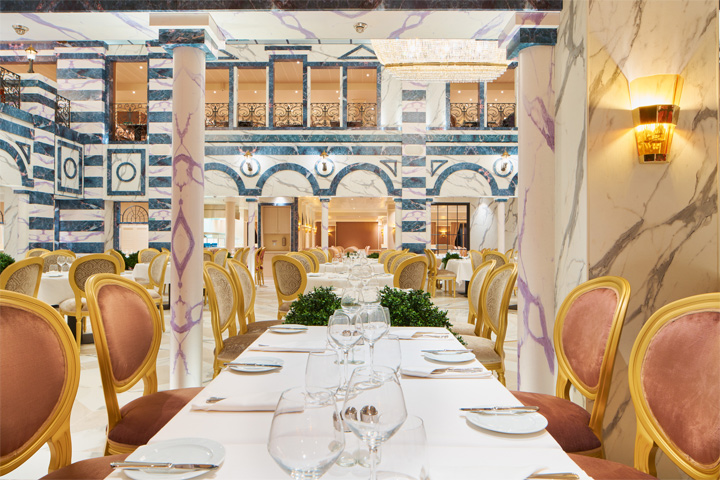
Ristorante de Medici
Main Dining
Main Dining Room: Carnival's Main Dining Room brings you a full three-course menu in an experience that's satisfying, but never stuffy. Drop in nightly and enjoy a rotating menu of delectable favorites like steak, roasted duck, scallops, prime rib, and, of course, sinfully delicious desserts.
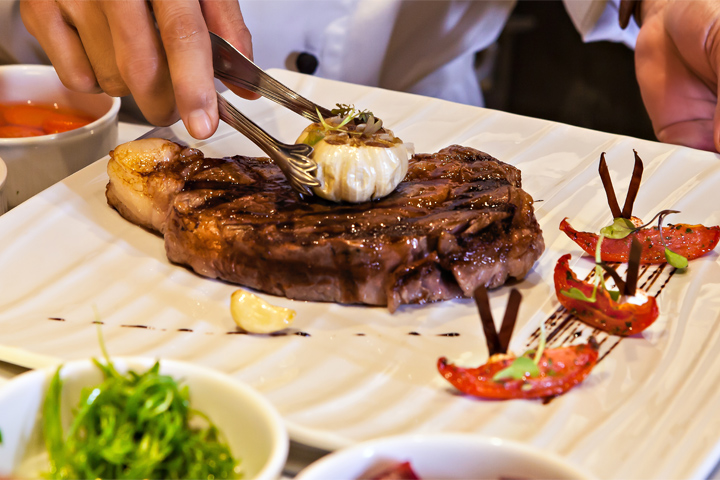
Steakhouse
Specialty Dining
Bonsai Sushi: Dine amidst expertly pruned bonsai trees while enjoying sit-down service and an affordable menu of delectable catches, plus soups, sides, sakes, and desserts. This restaurant is available for an additional cost.
Bonsai Teppanyaki: It's a meal, a performance, and it's definitely unforgettable. The Bonsai Teppanyaki experience is set to delight guests aboard Carnival Celebration. Take a little time out of vacation to sit down to a selection of tempting appetizers, before the chef prepares a main course featuring selections of meats, tofu, fish, shrimp or lobster… right at your table. In the teppanyaki tradition — and Carnival's tradition of fun — expect an interactive, satisfying meal full of surprise and delicious delight. This restaurant is available for an additional cost.
JavaBlue Café: From the simply caffeinated to the simply sublime, nothing satisfies your coffee craving like JavaBlue Café, featuring fun twists on the hot and cold drinks you enjoy, plus a mouth-watering assortment of baked treats. This restaurant is available for an additional cost.
Steakhouse: The menu features premium cuts of beef cooked to your specifications, as well as a fantastic selection of seafood, entrées, gourmet appetizers and an extensive wine list. Like any destination restaurant, reservations for Steakhouse are highly recommended. Your meal includes an appetizer, salad, entrée, side and dessert. This restaurant is available for an additional cost.
Seafood Shack: A good seafood dish is quite the catch. How ever you like yours served — whether it's on a roll, in a salad or atop a platter — Seafood Shack's the place to cast your net. Imagine a New England-style seaside spot where you can take it all in, enjoying a great meal complete with a side of ocean view. This restaurant is available for an additional cost.
24-Hour Room Service: There's a menu of salads, sandwiches and sweet stuff — completely free — during the day, plus hot food options available for a small fee. Late-night menu options (after 10 p.m.) are also available for a small fee.
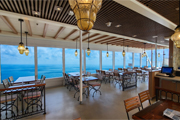
Lido Marketplace
Casual Dining
Lido Marketplace: Featuring an amazing variety of casual dining spots, each just a few flip-flopped steps from the last, Lido Marketplace always has a special something ready to satisfy your latest craving spectacularly. Here Carnival does it with dozens of what-to-eat options... great choices like BBQ, a deli counter, salad bar, an Asian station and a pasta bar... plus one spot where the chef serves up a different surprise daily! At Lido Marketplace, there's tons of indoor and outdoor seating made for gathering around, so you can enjoy your personal faves in your favorite company for lunch or dinner, or even breakfast! Lido's also where you can find soft serve, frozen yogurt and fresh pizza 24-hours a day.
Pizzeria del Capitano: Featuring piping hot slices right out of the oven, with your choice of toppings, Pizzeria del Capitano is the good kind of cheesy — the best reason to stop in for a taste of hand-tossed specialties made with fresh mozzarella. This place rolls out pizzas and Caesar salad 24 hours a day.
Disclaimer regarding ship dining
This stateroom offers two lower beds that convert to a queen-size bed and two pullman beds.
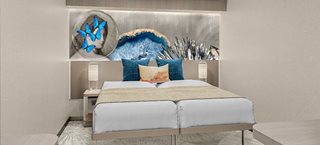
Category: I4

Category: IA

Category: IB

Category: IF

Category: IX

Category: IT
These staterooms offer clear views of the ocean, two single beds that convert to a queen-size bed, and a private bathroom.

Category: O4

Category: OA

Category: OB

Category: OX

Category: OT
These staterooms include two lower beds that convert to a queen-size bed and additional bedding for up to 2 guests.
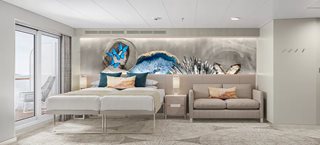
Category: B1

Category: B4

Category: BA

Category: BB

Category: BF

Category: BX

Category: BT
Suites offer a comfortable bedroom, a living area and a private balcony.

Category: MX

Category: MB

Category: MA

Category: M4
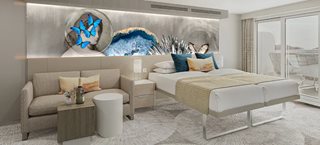
Category: M2
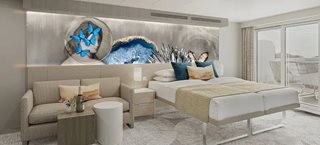
Category: SL
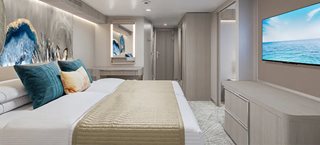
Category: SK
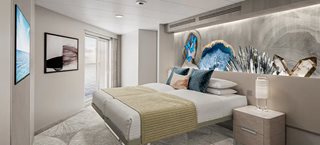
Category: SJ
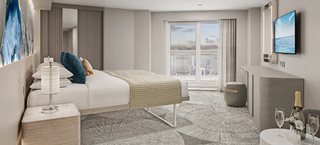
Category: SI
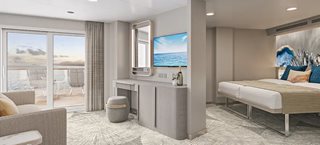
Category: SH

Category: HE
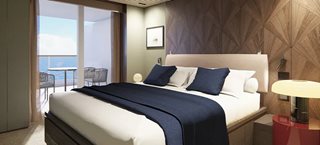
Category: HB
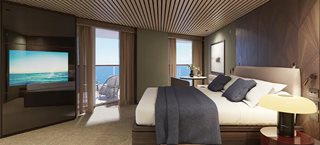
Category: HA
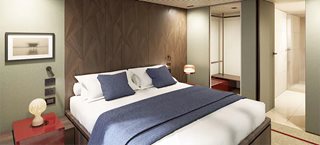
Category: H6
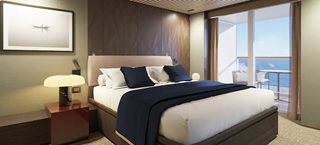
Category: H5
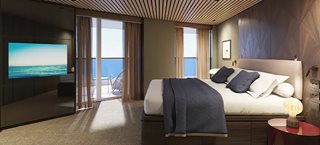
Category: H4

Category: H3

Category: H2
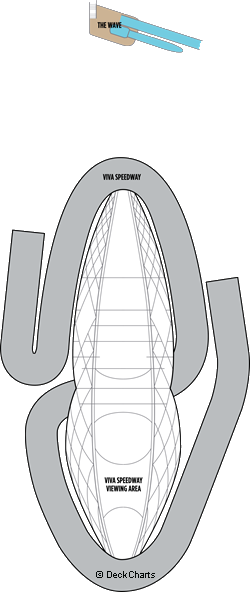
| Symbol | Description |
|---|---|
 | Stateroom with facilities for the disabled |
 | Connecting staterooms |
 | Third-person occupancy available |
 | Third- and/or fourth-person occupancy available |
 | Third-, fourth- and/or fifth-person occupancy available |
 | Up-to-sixth-person occupancy available |
 | Elevator |
 | Restroom |
 | Inside stateroom doors open to center interior corridors |
 | To be announced |
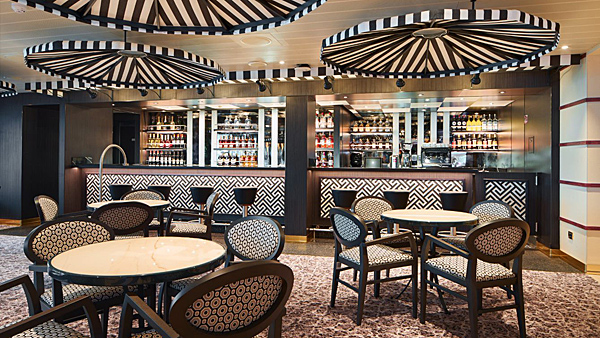
- Ship Name: Carnival Firenze
- Year Built: 2019
- Year Refurbished: 2022
- Year Entered Present Fleet: 2022
- Maximum Capacity: 5,245
- Number of Passenger Decks: 15
- Number of Crew: 1,424
- Officers' Nationality: International
- Ocean-View without Balcony: 273
- Ocean-View with Balcony: 956
- Total Inside Staterooms: 814
- Tonnage (GRT): 135,156
- Capacity Based on Double Occupancy: 4,126
- Country of Registry: Panama
- Total Staterooms: 2,063
- Suites with Balcony: 20
- Crew/Hotel Staff Nationality: International
Terms & Conditions
*Price shown is per person based on double occupancy, is valid for select stateroom categories only. Click on the Terms & Conditions link below for details.
†One Digital Costco Shop Card per room/stateroom, per stay. The exact amount of the Digital Costco Shop Card will be calculated during the booking process. The Digital Costco Shop Card promotion is nontransferable and may not be combined with any other promotion. A Digital Costco Shop Card will arrive by email approximately 10 days after the start of your cruise. Click on the Terms & Conditions link below for additional information.
Ship's Registry: Panama
Images are an artist's rendering.
Digital Costco Shop Card
This booking includes a Digital Costco Shop Card which will arrive by email one to two weeks after you return from your vacation. The Digital Costco Shop Card is a convenient payment option in our warehouses and on Costco.com.


















